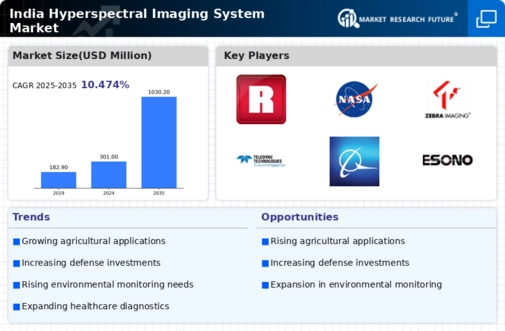The India Hyperspectral Imaging System Market is characterized by significant advancements in remote sensing technologies, leading to a surge in the adoption of hyperspectral imaging systems across various sectors such as agriculture, environmental monitoring, and defense. The competitive landscape is evolving rapidly, driven by the increasing demand for high-resolution imaging solutions that enable detailed analysis of materials and substances. As the market grows, several players are entering the fray, each bringing their unique strengths, capabilities, and innovative products to the table.
Companies in this space are heavily investing in research and development to enhance their offerings and maintain a competitive edge.
The growing awareness of the advantages of hyperspectral imaging, coupled with government support and initiatives aimed at promoting technology adoption, further amplifies the potential for market expansion. Avirtek stands out in the Indian hyperspectral imaging system market due to its strong focus on developing innovative imaging solutions tailored to local needs. The company has established a robust market presence by leveraging its cutting-edge technology to support various applications, particularly in the fields of agriculture and environmental monitoring.
Avirtek’s strengths lie in its ability to provide customized solutions that cater to the specific requirements of different sectors, backed by a team of skilled personnel proficient in hyperspectral imaging technologies. This adaptability has allowed Avirtek to build strong relationships with local clients and authorities, positioning itself as a reliable partner. With a commitment to customer satisfaction and excellence in service delivery, Avirtek is well-poised to capitalize on the growing demand for hyperspectral imaging solutions in India.
Raytheon also plays a crucial role in the Indian hyperspectral imaging system market, leveraging its extensive expertise in defense and aerospace technologies. The company has made significant strides in establishing its market presence through strategic investments and partnerships focused on delivering advanced imaging systems for military and surveillance applications. Key products and services offered by Raytheon include sophisticated sensor systems capable of capturing and processing hyperspectral data, which are crucial for intelligence-gathering and tactical operations. Raytheon's strengths lie in its robust research capabilities and commitment to innovation, enabling them to provide cutting-edge solutions that meet diverse customer needs.
Additionally, the company has engaged in various mergers and acquisitions within the region to enhance its technological capabilities and expand its market reach. With a strong emphasis on quality and reliability, Raytheon continues to position itself as a leader in the hyperspectral imaging space in India.


















